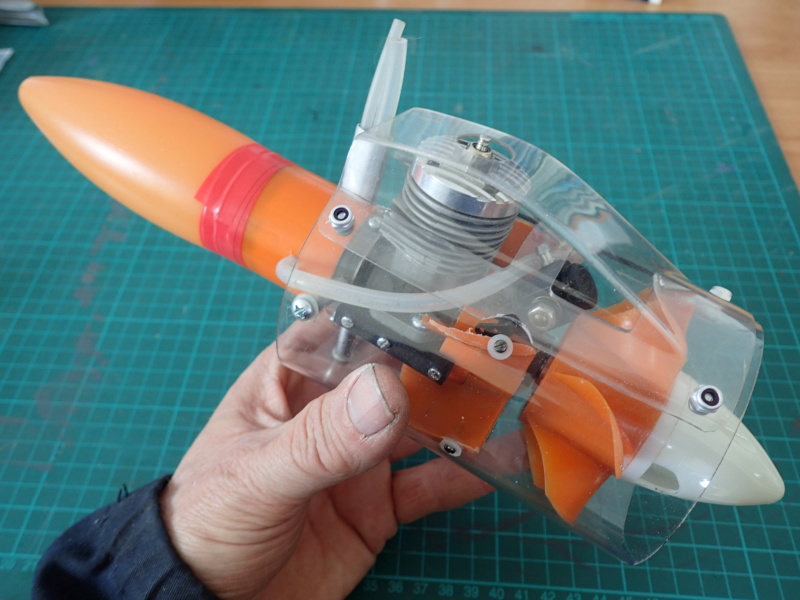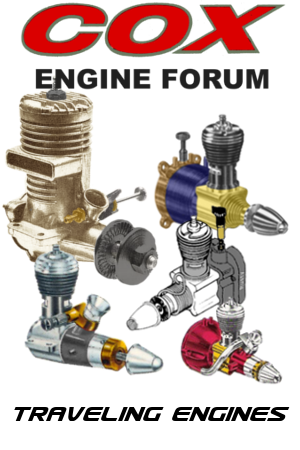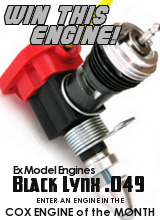Log in
Search
Latest topics
» Roddie's flat-bottomed boat..by OVERLORD Today at 10:11 am
» Tired of it all…
by Ken Cook Today at 8:04 am
» PT-19 Mayhem at Buder Park...a Decade Ago!!!!
by Kim Today at 7:41 am
» Project Cox .049 r/c & Citabrian Champion
by getback Today at 6:46 am
» Three -- sold out (making two more) Cox .010 Carburetors with wrench
by balogh Today at 12:34 am
» Joe Wagners Sioux
by GallopingGhostler Yesterday at 9:03 pm
» Happy Anzac Day!
by GallopingGhostler Yesterday at 4:16 pm
» Jim Walkers FireBee - This is going to be fun
by rsv1cox Yesterday at 12:27 pm
» Revivng Some Childhood Classics
by getback Yesterday at 7:31 am
» Fox .35 Modifications
by Ken Cook Yesterday at 3:16 am
» Introducing our Cox .049 TD Engines
by getback Fri Apr 26, 2024 6:20 am
» Cox powered jet-pump for model Sprint Boat
by roddie Thu Apr 25, 2024 10:25 pm
Cox Engine of The Month
The torque effect and Control line plane design
Page 1 of 1
 The torque effect and Control line plane design
The torque effect and Control line plane design
I have seen several references on the site to the torque effect induced by the spinning propeller when referring to control line flight. By torque effect I mean the tendency for the plane to want to roll in the opposite direction to the propeller.
I now have two control line models prepared and two in progress. However, these will be electric. My normal flying is RC and during the course of my progress I have made several observations. (mostly as a result of a near tragedy!)
These "observations" have been amplified by my watching progress in the CEF speed contest partcularly some of the struggles "taking off" and my imminent return to control line.
My only really disastrous flight in my previous control line history (some 45+ years ago) was with profile fuselage model with built up wings and a DC Bantam .75cc glo engine. My first glo engine and first profile model. I had previously flown 1.5 cc to 3.5 cc diesel models and, I have to say, never experienced slack lines always feeling a "pull" on the handle. This experience, the plane was uncontrollable, I first put down to being underpowered. Following the "handle" comments - I flew this with my then standard 4 1/2 " handle - I put it down to the handle. Then I got to thinking - "The lines were slack but it was flying!"
I have an inbuilt reluctance to repeat this and still somewhat of a disdain for profile models!
Back to my observations.
Firstly, with RC ( and I only fly electric "tail draggers").
1. All my planes have a distinct right thrust set.
2. If the wing and tail plane are in line with each other and the thrust line of the motor there is no downthrust set. (3D style aircraft usually!)
3. My "High wing" planes all have some downthrust set.
4. All planes have a tendency to roll a little to the left on take off and need a touch of aileron or rudder to correct.
5. Being Rc they are eay to trim true during flight. However this only usually is relative to speed.
6. Increase power on a "High winger", after trimming and it will climb and roll to the left.
7. On a 3D model, increasing power induces no climb but a left roll.
8. The smaller the plane - the more rapid is the roll and the climb when increasing power.
9. The larger the wingspan the more stable the plane remains.
10. Trying a more powerful motor with a larger propeller can be disastrous. A relatively stable model can turn into a skittish little deamon!
Now to control line.
1. I fly electric and am aware that in converting to electric I will be using larger propellers with more pitch. This will amplify the tendency to roll left or inwards.
2. My successful I.C. control liners all had a few things in common.
a. There was side thrust on the engine
b. The inboard wing was usually longer than the outboard wing.
c. Some had right thrust on the fin - Some didn't.
d. Some didn't have a fin.
3. Once the plane is in motion - you can't trim it on the fly!
My admiration for the CEF speed contest designs and the executions of the builds is immense. All my planes have been plan builds, kit builds and, in recent times, a.r.t.f.
To design and build a scale look alike with no provenance is a brave undertaking. To do this with the aim of a high power to weight ratio is even more adventurous. The two most difficult planes I fly are a 15" span Spitfire and a 14" Focke Wulf. They fly nicely when cruising but throttling up becomes stick waggling time with a vengance. I broke a propeller on one and replaced it with one which I thought was equivalent and it was unflyable!
After chatting with some electric control line chaps - their recommendation is to reverse the rotation (easy with electric, swap any two of the three wires to the ESC) and use a pusher propeller. This turns the torque effect to advantage for control line.
It does make me wonder if there would be an advantage to this with the Bee powered control liners, as the Bee will run quite happily in the opposite direction, and is there any clear advice on control line plane design?
It is obvious that there are clear favourites for stunt flying. The Skyray, Twister and Yak to name a few. What is there in the design of these and the other popular 1/2As that make them popular and comfortable to fly? What are the similar features in the designs?
I would welcome all comments and observations.
I now have two control line models prepared and two in progress. However, these will be electric. My normal flying is RC and during the course of my progress I have made several observations. (mostly as a result of a near tragedy!)
These "observations" have been amplified by my watching progress in the CEF speed contest partcularly some of the struggles "taking off" and my imminent return to control line.
My only really disastrous flight in my previous control line history (some 45+ years ago) was with profile fuselage model with built up wings and a DC Bantam .75cc glo engine. My first glo engine and first profile model. I had previously flown 1.5 cc to 3.5 cc diesel models and, I have to say, never experienced slack lines always feeling a "pull" on the handle. This experience, the plane was uncontrollable, I first put down to being underpowered. Following the "handle" comments - I flew this with my then standard 4 1/2 " handle - I put it down to the handle. Then I got to thinking - "The lines were slack but it was flying!"
I have an inbuilt reluctance to repeat this and still somewhat of a disdain for profile models!
Back to my observations.
Firstly, with RC ( and I only fly electric "tail draggers").
1. All my planes have a distinct right thrust set.
2. If the wing and tail plane are in line with each other and the thrust line of the motor there is no downthrust set. (3D style aircraft usually!)
3. My "High wing" planes all have some downthrust set.
4. All planes have a tendency to roll a little to the left on take off and need a touch of aileron or rudder to correct.
5. Being Rc they are eay to trim true during flight. However this only usually is relative to speed.
6. Increase power on a "High winger", after trimming and it will climb and roll to the left.
7. On a 3D model, increasing power induces no climb but a left roll.
8. The smaller the plane - the more rapid is the roll and the climb when increasing power.
9. The larger the wingspan the more stable the plane remains.
10. Trying a more powerful motor with a larger propeller can be disastrous. A relatively stable model can turn into a skittish little deamon!
Now to control line.
1. I fly electric and am aware that in converting to electric I will be using larger propellers with more pitch. This will amplify the tendency to roll left or inwards.
2. My successful I.C. control liners all had a few things in common.
a. There was side thrust on the engine
b. The inboard wing was usually longer than the outboard wing.
c. Some had right thrust on the fin - Some didn't.
d. Some didn't have a fin.
3. Once the plane is in motion - you can't trim it on the fly!
My admiration for the CEF speed contest designs and the executions of the builds is immense. All my planes have been plan builds, kit builds and, in recent times, a.r.t.f.
To design and build a scale look alike with no provenance is a brave undertaking. To do this with the aim of a high power to weight ratio is even more adventurous. The two most difficult planes I fly are a 15" span Spitfire and a 14" Focke Wulf. They fly nicely when cruising but throttling up becomes stick waggling time with a vengance. I broke a propeller on one and replaced it with one which I thought was equivalent and it was unflyable!
After chatting with some electric control line chaps - their recommendation is to reverse the rotation (easy with electric, swap any two of the three wires to the ESC) and use a pusher propeller. This turns the torque effect to advantage for control line.
It does make me wonder if there would be an advantage to this with the Bee powered control liners, as the Bee will run quite happily in the opposite direction, and is there any clear advice on control line plane design?
It is obvious that there are clear favourites for stunt flying. The Skyray, Twister and Yak to name a few. What is there in the design of these and the other popular 1/2As that make them popular and comfortable to fly? What are the similar features in the designs?
I would welcome all comments and observations.
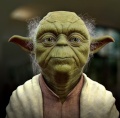
ian1954- Diamond Member

- Posts : 2688
Join date : 2011-11-16
Age : 69
Location : England
 Re: The torque effect and Control line plane design
Re: The torque effect and Control line plane design
Bees were used in reverse rotation on product planes to good effect.
When sizing an electric motor to a CL application look at prop diameter and theoretical speed to determine the motor selection. This is more important than watts output. If a CL airplane is designed for a 10 inch diameter prop, chances are you can only go an inch bigger anyways. Pitch and RPM determine theoretical speed via some mathematical mumbo jumbo (I can look up the formula, and so can any of you, but there are calculators that do the job easily too) By matching the theoretical speed at 80% throttle to similar to the glow power model then the performance should be similar enough that a slight RPM change is all it takes to get to ideal performance.
I have been trying to wrap my brain around this myself. I know that trying to match the RPM to glow power doesn't work well since glow is much faster. A high cell count battery is needed, pushing everything pretty hard, when changing the propeller pitch some means a common 3 or 4 cell battery is all that is needed.
Phil
When sizing an electric motor to a CL application look at prop diameter and theoretical speed to determine the motor selection. This is more important than watts output. If a CL airplane is designed for a 10 inch diameter prop, chances are you can only go an inch bigger anyways. Pitch and RPM determine theoretical speed via some mathematical mumbo jumbo (I can look up the formula, and so can any of you, but there are calculators that do the job easily too) By matching the theoretical speed at 80% throttle to similar to the glow power model then the performance should be similar enough that a slight RPM change is all it takes to get to ideal performance.
I have been trying to wrap my brain around this myself. I know that trying to match the RPM to glow power doesn't work well since glow is much faster. A high cell count battery is needed, pushing everything pretty hard, when changing the propeller pitch some means a common 3 or 4 cell battery is all that is needed.
Phil

pkrankow- Top Poster

- Posts : 3025
Join date : 2012-10-02
Location : Ohio
 Re: The torque effect and Control line plane design
Re: The torque effect and Control line plane design
That's a lot to digest, Ian. I'll re-read it when I have more free time, but I do have some comments.
All of the electric CL planes I've seen have the prop rotation it the opposite from conventional direction. This reduces the need for tip weight in the outboard wing. I have a lot to learn so far about electric power.
If I had reverse props for my Reed Speed plane I would no doubt prefer them. My incident I videoed was not due to rolling in so much as tall grass catching the lines. I hope to prove that to be true tomorrow for my official run.
As far as competitive precision stunters, you can drop the Yak-9 from the list, as it doesn't have quite the right architecture for the modern stunt pattern, either PAMPA or FAI. It is a stunt plane, but more a sport stunter than precision, very quick and twitchy and fun as hell to fly. The Shoestring is in that category too. The reason with the Yak is the thin airfoil and high wing loading. Also it's a low winger so not symmetrical when comparing upright and inverted during maneuvers, such as inside and outside loops. The Shoestring has a good thick airfoil, low wing loading, but like the Yak, a short tail moment(distance from TE to elevator hinge), so it's twitchy rather than smooth when attempting to fly perfect shapes. If you were to lengthen the SS and the Yak-9 tail moment and enlarge the stabilizer, they would be better suited for CLPA, Control Line Precision Aerobatics. I would love to do a SS up this way. I have a fond spot in my heart for that model, as it was my first bigger plane.
Modern pattern planes have long tail moments. The Twister, when built for precision aerobatics is modified with a longer tail, a mod introduced by Ted Fancher. The Skyray has the right nose and tail moments and is flapless, which makes it a good stunt trainer, easy to trim, and capable enough to fly and win in intermediate and possibly advanced classes.
In the higher classes, precision is so critical that profile planes are no longer adequate for top scores, as fuselage and tail flex are inherent sources of errors that limit their capability. That's when full fuselages and larger sizes, also more tolerant of wind, take over.
Profiles are easy to build and repair and quite capable and fun to fly. For a fun day at the field they are great to have. Hit the ground with a full fuse plane, and your day is over. With a profile, grab the glue and put it back in the air.
Rusty
All of the electric CL planes I've seen have the prop rotation it the opposite from conventional direction. This reduces the need for tip weight in the outboard wing. I have a lot to learn so far about electric power.
If I had reverse props for my Reed Speed plane I would no doubt prefer them. My incident I videoed was not due to rolling in so much as tall grass catching the lines. I hope to prove that to be true tomorrow for my official run.
As far as competitive precision stunters, you can drop the Yak-9 from the list, as it doesn't have quite the right architecture for the modern stunt pattern, either PAMPA or FAI. It is a stunt plane, but more a sport stunter than precision, very quick and twitchy and fun as hell to fly. The Shoestring is in that category too. The reason with the Yak is the thin airfoil and high wing loading. Also it's a low winger so not symmetrical when comparing upright and inverted during maneuvers, such as inside and outside loops. The Shoestring has a good thick airfoil, low wing loading, but like the Yak, a short tail moment(distance from TE to elevator hinge), so it's twitchy rather than smooth when attempting to fly perfect shapes. If you were to lengthen the SS and the Yak-9 tail moment and enlarge the stabilizer, they would be better suited for CLPA, Control Line Precision Aerobatics. I would love to do a SS up this way. I have a fond spot in my heart for that model, as it was my first bigger plane.
Modern pattern planes have long tail moments. The Twister, when built for precision aerobatics is modified with a longer tail, a mod introduced by Ted Fancher. The Skyray has the right nose and tail moments and is flapless, which makes it a good stunt trainer, easy to trim, and capable enough to fly and win in intermediate and possibly advanced classes.
In the higher classes, precision is so critical that profile planes are no longer adequate for top scores, as fuselage and tail flex are inherent sources of errors that limit their capability. That's when full fuselages and larger sizes, also more tolerant of wind, take over.
Profiles are easy to build and repair and quite capable and fun to fly. For a fun day at the field they are great to have. Hit the ground with a full fuse plane, and your day is over. With a profile, grab the glue and put it back in the air.
Rusty
_________________
Don't Panic!
...and never Ever think about how good you are at something...
while you're doing it!
My Hot Rock & Blues Playlist
...and never Ever think about how good you are at something...
while you're doing it!
My Hot Rock & Blues Playlist

RknRusty- Rest In Peace

- Posts : 10869
Join date : 2011-08-10
Age : 68
Location : South Carolina, USA
 Re: The torque effect and Control line plane design
Re: The torque effect and Control line plane design
I can't add much to what Rusty said, although I will say that tip weight sounds like something you were missing on that flight long ago.
Probably the single most popular profile is the Ringmaster. The SIG kits lack curb appeal in my humble opinion except for maybe the Banshee and Akrobat. Folks like them because they fly well without a whole lot of effort. If you want one, you had better buy now as they are being discontinued!
As Rusty mentioned full fuse is where you will end up at the competitive level. I just ordered this one

Probably the single most popular profile is the Ringmaster. The SIG kits lack curb appeal in my humble opinion except for maybe the Banshee and Akrobat. Folks like them because they fly well without a whole lot of effort. If you want one, you had better buy now as they are being discontinued!
As Rusty mentioned full fuse is where you will end up at the competitive level. I just ordered this one


Cribbs74- Moderator



Posts : 11895
Join date : 2011-10-24
Age : 50
Location : Tuttle, OK
 Re: The torque effect and Control line plane design
Re: The torque effect and Control line plane design
I searched for the Lark, but this is different, more like a Thunderbird.
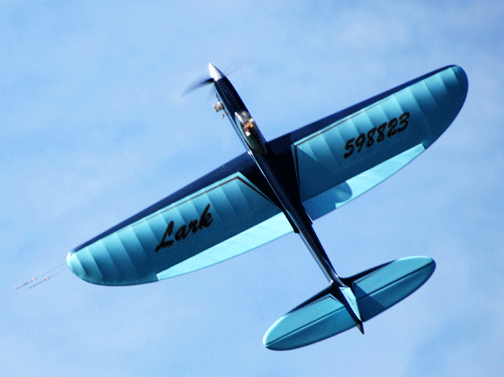

_________________
Don't Panic!
...and never Ever think about how good you are at something...
while you're doing it!
My Hot Rock & Blues Playlist
...and never Ever think about how good you are at something...
while you're doing it!
My Hot Rock & Blues Playlist

RknRusty- Rest In Peace

- Posts : 10869
Join date : 2011-08-10
Age : 68
Location : South Carolina, USA
 Re: The torque effect and Control line plane design
Re: The torque effect and Control line plane design
It's a Charles Mackey design. 1964ish? Anyway kitted by RSM.
Edit: I was wrong it's featured in the Feb 1960 issue of MAN
Edit: I was wrong it's featured in the Feb 1960 issue of MAN

Cribbs74- Moderator



Posts : 11895
Join date : 2011-10-24
Age : 50
Location : Tuttle, OK
 Re: The torque effect and Control line plane design
Re: The torque effect and Control line plane design
I was thinking of buying a few twisters and god forbid a couple of the cursed Staggerwings. Beechcraft Staggerwing speed contest anyone?Cribbs74 wrote:
The SIG kits lack curb appeal in my humble opinion except for maybe the Banshee and Akrobat. Folks like them because they fly well without a whole lot of effort. If you want one, you had better buy now as they are being discontinued.

I would run all of my reedies reverse rotation if there were props available.
Jim

JPvelo- Diamond Member

- Posts : 1972
Join date : 2011-12-02
Age : 56
Location : Colorado
 Re: The torque effect and Control line plane design
Re: The torque effect and Control line plane design
A very simple solution to the torque roll is to add a slight bit more of tip weight. The other is to use a single gear. Splay the gear over to the inboard side about 35-40 deg angle. This will place your outboard tip on the ground. This is how you will launch tip down. It wears the wheel a bit funny but you can turn the wheel around when it really starts to wear. If you can find Don's speed wheels, these were very good quality but due to their age now they may be a bit dry rotted. When launching, arm fully extended and run backwards prior to launch as if your snatching the plane off the ground. Don't launch the plane and expect it to roll off like a stunter as it will do what it did to Rusty immediately. Building a dolly and losing the gear will not only yield safer take offs, but you will go faster due to less drag. Ken

Ken Cook- Top Poster

- Posts : 5455
Join date : 2012-03-27
Location : pennsylvania
 Re: The torque effect and Control line plane design
Re: The torque effect and Control line plane design
JPvelo wrote:I was thinking of buying a few twisters and god forbid a couple of the cursed Staggerwings. Beechcraft Staggerwing speed contest anyone?Cribbs74 wrote:
The SIG kits lack curb appeal in my humble opinion except for maybe the Banshee and Akrobat. Folks like them because they fly well without a whole lot of effort. If you want one, you had better buy now as they are being discontinued.
I would run all of my reedies reverse rotation if there were props available.
Jim
There are a lot of reverse rotation props available, just do some looking.
OK, maybe fewer than I thought...
http://www3.towerhobbies.com/cgi-bin/wti0001p?&I=LXNGV1&P=7
Phil

pkrankow- Top Poster

- Posts : 3025
Join date : 2012-10-02
Location : Ohio
 Re: The torque effect and Control line plane design
Re: The torque effect and Control line plane design
This is a very interesting thread. Most of the airplane models/plans available are someone else’s design. Many are proven designs for their purpose.. but all require some serious thought if even slight deviations are made. This in turn makes “designers” out of all of us, in a way.
I personally love to design model airplanes, and have tried unorthodox methods in their construction. Some were successes, some were failures. I believe there are yet to be more great advances in design, some may not be “simple” to achieve… but Aeronautics is no simple matter.
Some years ago; I had given some thought to a wiggle-rudder for control-line models. A “cam” actuated and hinged rudder, on an otherwise conventional tail-plane, that would deflect only with elevator movement “off-neutral”. The amount of deflection should be variable if possible, for trimming purposes. This idea is an effort to improve line-tension when turning, where it’s desirable.
I have several l/h props for my Cox Bee’s, which I purchased along with the same brand, dia. and pitch r/h ones, solely for R/C multi-engine use with the intent to run the l/h prop on the starboard (right) side; thus splitting the torque forces equally.. and either of an “engine-out” scenario would be easier to control.. as opposed to losing the left engine with both running with conventional rotations.
I have often wondered why; if most conventional rotary-valve model engines run right-hand, producing these torque-forces, why then; do control-line models have their lead-outs on the port side? Could it be because most people are right-handed?
Re; Ken’s comment, the TopFlite Jr. Flite Streak (and possibly the full-size?) recommend a single gear-leg design, although it is shown vertical and not canted inboard.
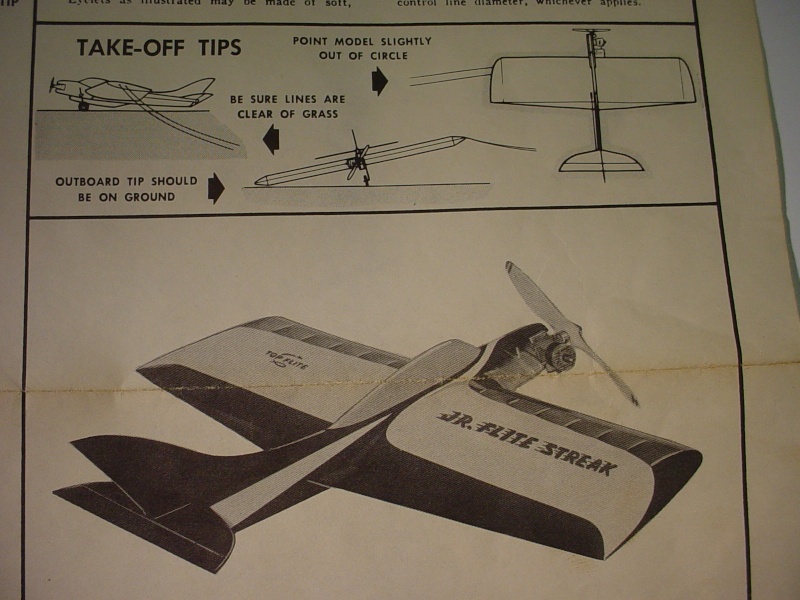
I personally love to design model airplanes, and have tried unorthodox methods in their construction. Some were successes, some were failures. I believe there are yet to be more great advances in design, some may not be “simple” to achieve… but Aeronautics is no simple matter.
Some years ago; I had given some thought to a wiggle-rudder for control-line models. A “cam” actuated and hinged rudder, on an otherwise conventional tail-plane, that would deflect only with elevator movement “off-neutral”. The amount of deflection should be variable if possible, for trimming purposes. This idea is an effort to improve line-tension when turning, where it’s desirable.
I have several l/h props for my Cox Bee’s, which I purchased along with the same brand, dia. and pitch r/h ones, solely for R/C multi-engine use with the intent to run the l/h prop on the starboard (right) side; thus splitting the torque forces equally.. and either of an “engine-out” scenario would be easier to control.. as opposed to losing the left engine with both running with conventional rotations.
I have often wondered why; if most conventional rotary-valve model engines run right-hand, producing these torque-forces, why then; do control-line models have their lead-outs on the port side? Could it be because most people are right-handed?
Re; Ken’s comment, the TopFlite Jr. Flite Streak (and possibly the full-size?) recommend a single gear-leg design, although it is shown vertical and not canted inboard.

 Re: The torque effect and Control line plane design
Re: The torque effect and Control line plane design
Roddie, that's called a Rabe Rudder. Designed by Al Rabe. Some people use it, and I have seen one, though it is uncommon. It adds yet another trim element to stunters.roddie wrote:...
Some years ago; I had given some thought to a wiggle-rudder for control-line models. A “cam” actuated and hinged rudder, on an otherwise conventional tail-plane, that would deflect only with elevator movement “off-neutral”. The amount of deflection should be variable if possible, for trimming purposes. This idea is an effort to improve line-tension when turning, where it’s desirable....
Rusty
_________________
Don't Panic!
...and never Ever think about how good you are at something...
while you're doing it!
My Hot Rock & Blues Playlist
...and never Ever think about how good you are at something...
while you're doing it!
My Hot Rock & Blues Playlist

RknRusty- Rest In Peace

- Posts : 10869
Join date : 2011-08-10
Age : 68
Location : South Carolina, USA
 Re: The torque effect and Control line plane design
Re: The torque effect and Control line plane design
RknRusty wrote:Roddie, that's called a Rabe Rudder. Designed by Al Rabe. Some people use it, and I have seen one, though it is uncommon. It adds yet another trim element to stunters.roddie wrote:...
Some years ago; I had given some thought to a wiggle-rudder for control-line models. A “cam” actuated and hinged rudder, on an otherwise conventional tail-plane, that would deflect only with elevator movement “off-neutral”. The amount of deflection should be variable if possible, for trimming purposes. This idea is an effort to improve line-tension when turning, where it’s desirable....
Rusty
Woah...... 4+ hour vid... ok.. gotta' reserve some time for that one. I was told by the N.E.S.T. guys back in the 90's, when I envisioned the idea; that it was known as a "wiggle-rudder".. and some modelers had experimented with it back before then. A few of those N.E.S.T. guys knew Windy Urtnowski personally.
 Re: The torque effect and Control line plane design
Re: The torque effect and Control line plane design
Yeah, Windy has made many full length videos about every aspect of building planes. I don't think he gets back to the Rabe linkage until about 1:47:30. But if you have some coffee, you can really learn a lot from watching him build.
Rusty
Rusty
_________________
Don't Panic!
...and never Ever think about how good you are at something...
while you're doing it!
My Hot Rock & Blues Playlist
...and never Ever think about how good you are at something...
while you're doing it!
My Hot Rock & Blues Playlist

RknRusty- Rest In Peace

- Posts : 10869
Join date : 2011-08-10
Age : 68
Location : South Carolina, USA
 Re: The torque effect and Control line plane design
Re: The torque effect and Control line plane design
RknRusty wrote:Yeah, Windy has made many full length videos about every aspect of building planes. I don't think he gets back to the Rabe linkage until about 1:47:30. But if you have some coffee, you can really learn a lot from watching him build.
Rusty
coffee..
 Re: The torque effect and Control line plane design
Re: The torque effect and Control line plane design
Rusty - Where have you been hiding the video?
This should have been edited and sold as a "How to compilation". I have just watched the first part on setting up the rudder.
Sheer craftsmanship!
This should have been edited and sold as a "How to compilation". I have just watched the first part on setting up the rudder.
Sheer craftsmanship!

ian1954- Diamond Member

- Posts : 2688
Join date : 2011-11-16
Age : 69
Location : England
 Re: The torque effect and Control line plane design
Re: The torque effect and Control line plane design
Ron, I love your taste. I do have the RSM version myself. Bob Hunt built Shawn the wing for a Mackey Lark. Shawn won a contest in Maryland a few years ago. Bob was very impressed and built the wing for Shawn as a gift for winning. A very very generous gift. I haven't finished the plane, but it seems like a Aero Tiger .36 might be the best power choice. Bob's Lark which is the one pictured as the box art was a terrific flying plane. Ken

Ken Cook- Top Poster

- Posts : 5455
Join date : 2012-03-27
Location : pennsylvania
 Re: The torque effect and Control line plane design
Re: The torque effect and Control line plane design
Ken Cook wrote: Ron, I love your taste. I do have the RSM version myself. Bob Hunt built Shawn the wing for a Mackey Lark. Shawn won a contest in Maryland a few years ago. Bob was very impressed and built the wing for Shawn as a gift for winning. A very very generous gift. I haven't finished the plane, but it seems like a Aero Tiger .36 might be the best power choice. Bob's Lark which is the one pictured as the box art was a terrific flying plane. Ken
Thanks much Ken,
I don't want to hi-jack Ian's thread too bad, but I am planning on a Fox .40. If I can get Lew to modify it for me then I'll be a happy camper. You need to finish yours so you can give me advice!
Ian,
Have you considered the Pinto from RSM? Full fuse and doesn't take up much real estate.

Cribbs74- Moderator



Posts : 11895
Join date : 2011-10-24
Age : 50
Location : Tuttle, OK
 Re: The torque effect and Control line plane design
Re: The torque effect and Control line plane design
Strange you should say that. I came across RSM Distribution last week and they specialise in electrickery and control line.
I placed a good order with them - pusher props, timers and had a good scan through the kits.
I spoke to Eric Rule on the phone, extremley nice chap and very helpful. I will see how this order goes but it is looking promising!
I placed a good order with them - pusher props, timers and had a good scan through the kits.
I spoke to Eric Rule on the phone, extremley nice chap and very helpful. I will see how this order goes but it is looking promising!

ian1954- Diamond Member

- Posts : 2688
Join date : 2011-11-16
Age : 69
Location : England
 Re: The torque effect and Control line plane design
Re: The torque effect and Control line plane design
ian1954 wrote:Rusty - Where have you been hiding the video?
This should have been edited and sold as a "How to compilation". I have just watched the first part on setting up the rudder.
Sheer craftsmanship!
Just an FYI.. the above vid is doubled.. although it states 4:20:14, it is only 2:10:07 in actual duration. I hope that Rusty can find the remaining build footage on the rudder linkage.
 Re: The torque effect and Control line plane design
Re: The torque effect and Control line plane design
Ah crap it stops at 2:10. A SH member recently posted many of Windy's videos on youtube. It'll be in there somewhere. Oh well, sorry about that. I'll stop hijacking Ian's thread and continue if I see any Windy videos that fit with CEF subjects. The dude can build with amazing skill,
Rusty
Rusty
_________________
Don't Panic!
...and never Ever think about how good you are at something...
while you're doing it!
My Hot Rock & Blues Playlist
...and never Ever think about how good you are at something...
while you're doing it!
My Hot Rock & Blues Playlist

RknRusty- Rest In Peace

- Posts : 10869
Join date : 2011-08-10
Age : 68
Location : South Carolina, USA
 Torque effect & design considerations for C/L protospeed models
Torque effect & design considerations for C/L protospeed models
Hi Ian,
Here's an article I did some time ago regarding C/L proto models where torque effect is a very important design consideration.
Cheers, Paul
Protospeed designs are a fascinating concept & have more considerations than a pure speed model which can be quite straight forward.
Perhaps I will go over a few basics. (or not so basic, but 'secret'?) I published all this some time ago...
The MOST IDEAL F-40 (or ANY proto) layout is what I call the "Wisniewski Layout". That is:
- flown clockwise
- cowl on bottom (which 1. fairs in LG LEG and 2. keeps C of G lower for SMOOTHER takeoffs 3. gives increased line tension on takeoff)
- rudder on top for increased line tension on takeoff
- needs NO TIP WT = lighter model hence faster acceleration
- uses tractor props which are plentiful
- pilot can have handle in pylon on takeoff, essentially travelling less total distance
I have seen the Wisniewski Pink Lady model flown CCW once, but from what I can gather, not a nice layout to takeoff or fly... Other than that one flight, I know of no other successful users of that layout.
Now since we modellers are a stubborn lot who DON'T LIKE TO FLY CW, then we have to live with a few COMPROMISES THAT WILL REDUCE SPEED.
Given that most of us fly CCW we need to change a few things like:
-need to have cowl on top & rudder on bottom for best line tension on takeoff. L.G. now has more drag.
- need to use some tip weight for NECESSARY line tension on takeoff, model is now heavier
- leadout position is MORE CRITICAL, (too far fwd is dangerous on takeoff, model will roll in on you)
I believe the rudder/cowl orientation have to do with spiral slipstream around the fuse, and FIRMLY BELIEVE they play an important part on takeoff.
i.e. I saw the Marty Shoenheiter (from Utah) experiment with a wheel fairing. Model always rolled in on takeoff w/ the fairing. When removed, the takeoff was then OK. Who would have thought the spiral slipstream was so noticeable?
Now in order for a CCW flier to avoid the compromises you can indeed go the L/H prop route... So flying normal direction CCW & using a L/H prop:
- no tip weight is needed
- rudder is best on top ala Wisniewski & Kirn
- cowl is best on bottom
(rudder on bottom/cowl on top might work against you (somewhat) but are probably much less critical/important in this case all being more than offset offset by the L/H prop rotation)
- leadout position is less critical
- supply of L/H props is much less.
In absolute terms the use of a rudder that's both on top & on bottom is unknown, but I suspect the top rudder will cancel out the sub rudder. I note that most International Class aerobatic flyers over here have all gone to L/H APC props on their (CCW flown) electric powered models. Why not, when it only helps in all ways to maintain a good line tension & is just so easy to do thanks to the people at APC.
Cheers, Paul
Here's an article I did some time ago regarding C/L proto models where torque effect is a very important design consideration.
Cheers, Paul
Protospeed designs are a fascinating concept & have more considerations than a pure speed model which can be quite straight forward.
Perhaps I will go over a few basics. (or not so basic, but 'secret'?) I published all this some time ago...
The MOST IDEAL F-40 (or ANY proto) layout is what I call the "Wisniewski Layout". That is:
- flown clockwise
- cowl on bottom (which 1. fairs in LG LEG and 2. keeps C of G lower for SMOOTHER takeoffs 3. gives increased line tension on takeoff)
- rudder on top for increased line tension on takeoff
- needs NO TIP WT = lighter model hence faster acceleration
- uses tractor props which are plentiful
- pilot can have handle in pylon on takeoff, essentially travelling less total distance
I have seen the Wisniewski Pink Lady model flown CCW once, but from what I can gather, not a nice layout to takeoff or fly... Other than that one flight, I know of no other successful users of that layout.
Now since we modellers are a stubborn lot who DON'T LIKE TO FLY CW, then we have to live with a few COMPROMISES THAT WILL REDUCE SPEED.
Given that most of us fly CCW we need to change a few things like:
-need to have cowl on top & rudder on bottom for best line tension on takeoff. L.G. now has more drag.
- need to use some tip weight for NECESSARY line tension on takeoff, model is now heavier
- leadout position is MORE CRITICAL, (too far fwd is dangerous on takeoff, model will roll in on you)
I believe the rudder/cowl orientation have to do with spiral slipstream around the fuse, and FIRMLY BELIEVE they play an important part on takeoff.
i.e. I saw the Marty Shoenheiter (from Utah) experiment with a wheel fairing. Model always rolled in on takeoff w/ the fairing. When removed, the takeoff was then OK. Who would have thought the spiral slipstream was so noticeable?
Now in order for a CCW flier to avoid the compromises you can indeed go the L/H prop route... So flying normal direction CCW & using a L/H prop:
- no tip weight is needed
- rudder is best on top ala Wisniewski & Kirn
- cowl is best on bottom
(rudder on bottom/cowl on top might work against you (somewhat) but are probably much less critical/important in this case all being more than offset offset by the L/H prop rotation)
- leadout position is less critical
- supply of L/H props is much less.
In absolute terms the use of a rudder that's both on top & on bottom is unknown, but I suspect the top rudder will cancel out the sub rudder. I note that most International Class aerobatic flyers over here have all gone to L/H APC props on their (CCW flown) electric powered models. Why not, when it only helps in all ways to maintain a good line tension & is just so easy to do thanks to the people at APC.
Cheers, Paul

Paulgibeault- Gold Member

- Posts : 259
Join date : 2011-09-24
Location : Leduc, Alberta Canada
 Re: The torque effect and Control line plane design
Re: The torque effect and Control line plane design
More fascinating comment. Thank you.
I think the poblems of "spiral slipstream" exists particularly on take off when the thrust line of the aeroplane is not parallel with the direction of travel.
I have also seen several references to the effect that wheel spats can have.
That is why I have my admiration for the designers of these models.
Once the control line model is released - if anything is not quite right then you are committed!
With RC models - there is still a chance to make adjustments.
I think the poblems of "spiral slipstream" exists particularly on take off when the thrust line of the aeroplane is not parallel with the direction of travel.
I have also seen several references to the effect that wheel spats can have.
That is why I have my admiration for the designers of these models.
Once the control line model is released - if anything is not quite right then you are committed!
With RC models - there is still a chance to make adjustments.

ian1954- Diamond Member

- Posts : 2688
Join date : 2011-11-16
Age : 69
Location : England
 Similar topics
Similar topics» How do you fly a control line plane
» dolar store electric control line plane build
» Torque effect on C/L Proto model
» control line P-38
» fishing line to use for control line
» dolar store electric control line plane build
» Torque effect on C/L Proto model
» control line P-38
» fishing line to use for control line
Page 1 of 1
Permissions in this forum:
You cannot reply to topics in this forum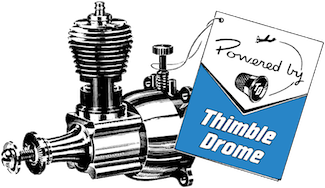

 Rules
Rules